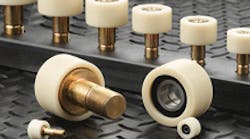Authored by: |
Engineering design is the art of compromise. Engineers typically select components by weighing criteria such as function, reliability, availability, and cost. In the case of cam followers, however, engineers generally don’t have much choice. With few options other than the brand, designers are often forced to accept costly features and operational limits.
For example, conventional metal cam followers are built for relatively high loads, and that’s overkill in light-duty applications. Rail or cam surfaces have to be hardened. And users have to provide manual or central lubrication or the bearing and rail can catastrophically fail. Yet excessive grease can contaminate surrounding products and lead to cam-follower skidding and wear.
Engineers must also consider the shock and vibration caused by metal-to-metal impact. And the potential for metal particles and grease contamination often restricts use in the growing clean-room market. Finally, the relatively low rotating speed of the needle bearings in these devices, combined with high rolling resistance and inertia, may limit their use in high-speed equipment.
Cam followers that use plastic-composite “tires” are a viable alternative to traditional designs. The iCam followers from Intech, Closter, N. J., for instance, include two roller bearings and a zinc-plated shaft, and are dimensionally interchangeable with metal followers.
They are especially helpful when the cam follower’s primary function is to transmit motion rather than carry high loads. Today’s trend is toward high-speed, lightweight, and light-duty machines in processing, packaging, medical, and semiconductor equipment. In these applications, iCam followers easily carry the load while simplifying design. Other advantages include:
Lube-free. The self-lubricating plastic tire requires no lubrication between the cam follower and rail, saving on grease and maintenance. The precision ball bearings encapsulated by the tire are lubricated for life.
Minimal wear. Metal cam followers can wear and damage the rails, especially aluminum ones, which doesn’t happen with plastic rollers.
Low noise. Composite tires absorb shock and vibration and run up to 10 dB quieter than comparable metal followers. Runout below ±0.001 in. contributes to smooth and quiet rolling.
No particulates. Particularly important in clean rooms, food processing, and pharmaceutical production, iCam followers do not generate metal particles because the plastic tire is softer than a steel or aluminum rail. And properly sized, wear on the followers is negligible. Clean-room designs use stainless-steel bearings and shafts and special bearing grease.
Low inertia. A typical iCam follower weighs about 40% less than a same-size metal cam follower, which becomes especially important at high speeds. Low rolling resistance and lack of external lubrication also contribute to high-speed capabilities.
Harsh environments. For saltwater, chemical, and sanitary environments, iCam followers come with stainless-steel bearings and shafts and in enclosed versions. In addition, the plastic does not absorb moisture, permitting use at subzero temperatures.
The key to ensuring high performance and long life is accurately sizing the cam followers for the relevant static and dynamic loads. Intech engineers have developed software that considers load data such as radial and axial forces, duty cycle, and linear speed to quickly assess whether an ICam follower suits an application.
About the Author
Kenneth Korane
Ken Korane holds a B.S. Mechanical Engineering from The Ohio State University. In addition to serving as an editor at Machine Design until August 2015, his prior work experience includes product engineer at Parker Hannifin Corp. and mechanical design engineer at Euclid Inc.
